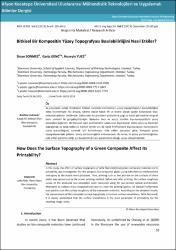| dc.contributor.author | Sönmez, Sinan | |
| dc.contributor.author | Genç, Garip | |
| dc.contributor.author | Yüce, Hüseyin | |
| dc.date.accessioned | 2021-06-18T07:07:18Z | |
| dc.date.available | 2021-06-18T07:07:18Z | |
| dc.date.issued | 2019 | en_US |
| dc.identifier.citation | Sonmez, S , Genc, G , Yuce, H . (2019). How Does the Surface Topography of a Green Composite Affect its Printability? . Afyon Kocatepe Üniversitesi Uluslararası Mühendislik Teknolojileri ve Uygulamalı Bilimler Dergisi , 2 (2) , 55-60 | en_US |
| dc.identifier.uri | https://dergipark.org.tr/tr/pub/akuumubd/issue/45622/558921 | |
| dc.identifier.uri | https://hdl.handle.net/11630/8736 | |
| dc.description.abstract | In this study, the effect of surface topography of luffa fiber reinforced green composite materials on its
printability was investigated. For this purpose, bio-composite plates using luffa fiber as reinforcement
and epoxy as the matrix were produced. Then, printing such as line and dot on the surfaces of these
plates was carried out by the screen printing method. Before and after printing, the surface roughness
values of the produced bio-composites were measured using 3D non-contact optical profilometer.
Afterward, to validate these measurements and to check the printing quality, 3D Optical Profilometer
was used to scan the surface roughness of bio-composite materials. According to the obtained results,
the improvement of the composite surface topography is increase surface smoothness. With this result,
it is clearly understood that the surface smoothness is the main parameter of printability for the
resulting image clarity. | en_US |
| dc.description.abstract | Bu çalışmada, kabak lifi takviyeli bitkisel kompozit malzemelerin yüzey topografyasının basılabilirliğine
etkisi incelenmiştir. Bu amaçla, takviye olarak kabak lifi ve matris olarak epoksi kullanılarak biyokompozit plakalar üretilmiştir. Daha sonra bu plakaların yüzeylerine çizgi ve nokta gibi baskılar serigrafi
baskı yöntemi ile gerçekleştirilmiştir. Baskıdan önce ve sonra, üretilen biyo-kompozitlerin yüzey
pürüzlülük değerleri, 3D temassız optik profilometre kullanılarak ölçülmüştür. Daha sonra bu ölçümleri
doğrulamak ve baskı kalitesini kontrol etmek için 3D Optik Profilometre biyo-kompozit malzemelerin
yüzey pürüzlülüğünü taramak için kullanılmıştır. Elde edilen sonuçlara göre, kompozit yüzey
topografyasındaki gelişme, yüzey pürüzsüzlüğünü arttırmaktadır. Bu sonuç ile yüzey pürüzsüzlüğünün,
elde edilen görüntü netliği için basılabilirliğin ana parametresi olduğu açıkça anlaşılmaktadır. | en_US |
| dc.language.iso | en | |
| dc.publisher | Afyon Kocatepe Üniversitesi | en_US |
| dc.relation.ispartof | Afyon Kocatepe Üniversitesi Uluslararası Mühendislik Teknolojileri ve Uygulamalı Bilimler Dergisi | |
| dc.rights | info:eu-repo/semantics/openAccess | en_US |
| dc.subject | Kabak Lifi | en_US |
| dc.subject | Bitkisel Lifler | en_US |
| dc.subject | Biyo-Kompozit | en_US |
| dc.subject | Basılabilirlik | en_US |
| dc.subject | Luffa Fiber | en_US |
| dc.subject | Plant Fibers | en_US |
| dc.subject | Bio-Composite | en_US |
| dc.subject | Printability | en_US |
| dc.title | How does the surface topography of a green composite affect its printability? | en_US |
| dc.title.alternative | Bitkisel bir kompozitin yüzey topografyası basılabilirliğini nasıl etkiler? | en_US |
| dc.type | Article | |
| dc.department | Fakülteler, Teknoloji Fakültesi, Mekatronik Mühendisliği Bölümü | en_US |
| dc.identifier.orcid | 0000-0003-3126-9590 | en_US |
| dc.identifier.orcid | 0000-0001-7711-3845 | en_US |
| dc.identifier.orcid | 0000-0001-5525-7733 | en_US |
| dc.identifier.volume | 2 | en_US |
| dc.identifier.startpage | 55 | en_US |
| dc.identifier.endpage | 60 | en_US |
| dc.identifier.issue | 2 | en_US |
| dc.relation.publicationcategory | Makale - Ulusal Hakemli Dergi - Başka Kurum Yazarı | en_US |



















